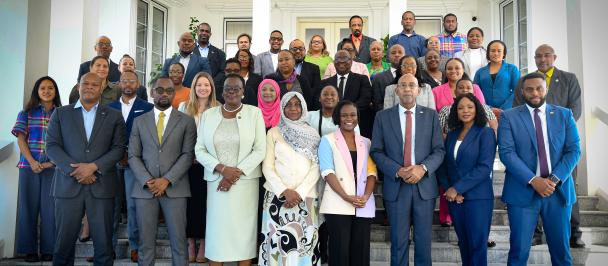Sustaining all life on earth
In the Caribbean, there is a universal feature that many admire, enjoy and make their living from, but far too few defend from its decay: the sea. More than a prime location for leisure, the sea holds potential for expansion, innovation and the emergence of business, pharmaceuticals and energy resources. The blue economy has been identified as the pathway for sustainable development which small island developing states need, to diversify their economies and build climate resilience.
But the sea is in great danger, and with it, the Caribbean’s biodiversity and high endemism, its coral reefs, mangroves and seagrass, which provide important feeding and breeding grounds for more than 1,300 species of fish, marine mammals and sea turtles. Overexploitation, climate change, habitat destruction from infilling mangroves, coral bleaching and, above all, plastic pollution, are dangerous attacks on the health of the seas.
On this World Wildlife Day aimed at “Sustaining all Life on Earth”, the threat of plastics to Caribbean wildlife, and thus on the region’s blue economy, can be told by numbers. Over 8.3 billion tonnes of plastic has been produced since the 1950s, and about 60% has ended up in the environment or in a landfill. Globally, about 300 million tonnes of plastic waste are produced annually – nearly the weight of the entire human population. We buy 1 million plastic drinking bottles every minute and use 5 trillion single use bags every year. Humanity is addicted to plastic.
For wildlife, plastics are a lethal hazard because animals consume them, in small pieces (microplastics), which can disrupt their digestion and lead to death. Photos of wildlife with stomachs full of waste particles only tell one part of the story: many of these plastics will make it to our tables. These plastics have socioeconomic implications. The International Coastal Clean-up in Barbados in 2019 reported collection of 34,105 pieces of plastic. Studies have found as many as 200,000 pieces of plastic per square kilometre in the Caribbean Sea – estimated at 3 times the global average. The impact of plastic on commercially valuable fish species coupled with overexploitation pose significant challenges to blue economy livelihoods – fishers, vendors, processors, restaurateurs and others.
As with greenhouse gas emissions, the small islands of the Caribbean produce miniscule amounts compared to the giant polluters. However, persons living in the Caribbean are among the guiltiest. Ten of the world’s top thirty polluters per capita are from the Caribbean. Aware of this threat, the region has taken action. Antigua and Barbuda led the adoption of legislation banning single-use plastics in 2016, followed by Aruba in 2017. Styrofoam was banned in St. Vincent and the Grenadines in 2017 and Barbados and Dominica also started bans in 2019. UNDP is currently supporting many countries in the Eastern Caribbean transition towards reducing plastic pollution and is assisting Grenada and Montserrat to effect similar bans this year.
The region is full of innovators who, for instance, harness biotechnology to convert the troublesome sargassum seaweed into high quality agricultural products. Across the world, entrepreneurs and researchers are developing new products such as furniture and electronics from waste plastics, and the industry is moving increasingly to bioplastics and zero-packaging products. UNDP’s Blue Economy Accelerator Lab and UNDP-GEF Small Grants Programme are avenues for such exploration of solutions that balance the continuous economic development we need and the environmental sustainability we require to survive.
Habits define humans. Dropping plastic addiction is a huge step towards protecting wildlife. The oceans and the species within them are inseparable from the region’s economic development through the sustainable use of its resources. Plastics are not the only threat to wildlife and their ecosystems. Pollution from shipping, sewage, agricultural runoff, oil, and unmanaged coastal development are all a part of a much wider problem. But today, the focus is on the transparent destroyer. It is your choice: plastic … or planet?
Danielle Evanson, Head of the Sustainable Solutions and Energy Cluster, and Magdy Martinez Soliman, Resident Representative, UNDP Barbados and the Eastern Caribbean

 Locations
Locations




